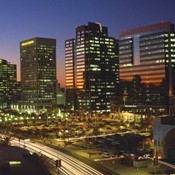Like many “new” cities in the Southwest, Phoenix would not best be described as compact and filled with cultural attractions that could be accessed without jumping into a car or motorcoach, but all that’s changing due to a number of facilities infilling the downtown of America’s fifth-largest metro. The Monopoly board is beginning to be developed, and planners are ready to pass “Go.”
According to Mayor Phil Gordon, much of the transformation is keyed to the new downtown campus for Arizona State University, along with the $900 million, privately financed CityScape mixed-use development.
The flurry of development will also reap dividends on the meetings side: the Phoenix Convention Center wrapped a five-year, $600 million expansion in December that amped up its offering to 900,000 square feet of exhibition and meeting space—big enough to accommodate more than 80 percent of the conventions in the U.S.; the 1,000-room Sheraton Downtown Phoenix—a prototype of the chain’s new brand identity and the largest hotel in the state—opened last October a block from the convention center; and METRO Light Rail, a 20-mile, $1.4 billion light-rail system, debuted at the end of 2008, linking downtown convention-goers to a variety of restaurants, nightlife and museums along the route.
“Five years ago, when I was elected, we took on a can-do attitude,” Gordon says. “Rather than take on a single project, we took on the mass and synergism at once and were not afraid to fail. We were working on 10 high-rises, which created a view that if we’re going to have that we’ll need new restaurants and bars, and we’ll need to expand the convention center, so we’ll need hotels.
“We basically put a plan together to have everything tie together and come together by the end of [2008],” Gordon continues. “It’s really a combination of ‘Let’s do it all at once.’”
While downtown has long stood in the shadow of outlying communities when it came to fine dining and cultural offerings, the shot of life injected via the university development will add many more people-friendly attractions to serve the influx of students and staff. Major signs of cultural renaissance can be seen during the First Friday Art Walk, an affair with a “grassroots” feel and featuring a collection of local artists who display their work in the historic Roosevelt Row neighborhood, which itself is brimming with new upscale dining venues.
Of course, considering today’s sputtering economy, ambitious development projects like this may wrinkle an eyebrow or two, but Mayor Gordon is known for his “glass is half full” attitude.
“The economy is tough, but we’ve always gone into it near the end and come out of it quickly,” Gordon says. “So when the market changes, the infrastructure is in place. We’re certainly now at the top of the second tier, and near the first tier. We can do conventions that are triple in size [than before]. We can also do multiple conventions, and we could never do that before. The ‘wow’ factor is here.”
But maybe Kevin Kamenzind, senior vice president of sales and marketing for the Greater Phoenix CVB, sums it up best with his enthusiasm: “We’re like a bunch of little kids with a new toy.”







